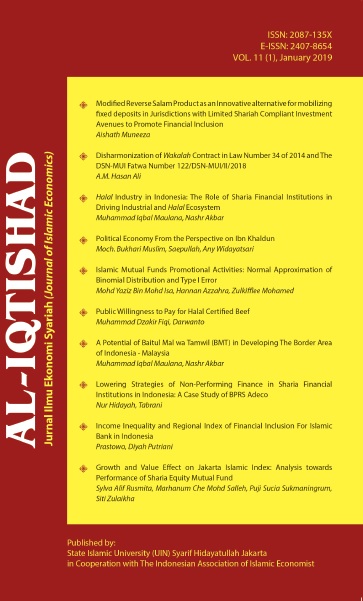Income Inequality and Regional Index of Financial Inclusion For Islamic Bank in Indonesia
DOI:
https://doi.org/10.15408/aiq.v11i1.8380Keywords:
Dimension – Financial Inclusion Index (2D-FII), Income Inequality, Poverty Alleviation, Islamic BanksAbstract
This research is proposed to measure financial inclusion index in 2 dimensions (2D-FII) in Indonesia Islamic banks. This research contributes to the measurement 2D-FII at the regional level in Indonesia. The analysis of crosssection data from 33 provinces in Indonesia between 2014 and 2015 shows that the value of FII in Islamic banking in Indonesia is still low. Previous works show one of the determinants on increasing inequality in any country is limited access to the financial sector, especially for low-income household (Akimov, Wijeweera, and Dollery 2006; Kenourgios and Samitas 2007; Levine 2003; D. Park and Shin 2015). Thus, the low level of FII in Indonesia perhaps is caused by inequality of income. Therefore, this research recommends policymaker to have more concern on poverty alleviation program and open new Islamic banks branches at the regional level.
Penelitian ini bertujuan untuk mengukur indeks inklusi keuangan pada 2 dimensi (2D-FII) pada bank-bank syariah di Indonesia. Secara umum, penelitian ini berkontribusi pada pengukuran 2D-FII di tingkat regional Indonesia. Analisis terhadap data dari 33 provinsi di Indonesia antara tahun 2014-2015 menunjukkan bahwa nilai FII pada perbankan syariah di Indonesia masih rendah. Kajian-kajian terdahulu menunjukkan bahwa salah satu penentu peningkatan ketimpangan di berbagai negara adalah akibat akses terhadap sector keuangan yang masih terbatas, khususnya pada rumah tangga dengan pendapatan rendah (Akimov, Wijeweera, and Dollery 2006; Kenourgios and Samitas 2007; Levine 2003; D. Park and Shin 2015). Dengan begitu, rendahnya tingkat FII di Indonesia bisa jadi disebabkan oleh ketimpangan pendapatan. Oleh karena itu, penelitian merekomendasikan pengambil kebijakan untuk lebih fokus pada program pengentasan kemiskinan dan pembukaan cabang-cabang bank syariah di tingkat regional.
References
Ahmad, Ziauddin. 1991. Islam, Poverty, and Income Distribution. The Islamic Foundation, Markfield Dawah Center.
Akimov, Alexandr, Albert Wijeweera & Brian Dollery. 2006. Finance-Growth Nexus: Evidence from Transition Economies B.
Ardic, Oya Pinar, Maximilien Heimann & Nataliya Mylenko. 2011. Access to Financial Services and the Financial Inclusion Agenda around the World: A Cross-Country Analysis with a New Data Set (English). Policy Research working paper; no. WPS 5537. Washington, DC: World Bank. http://documents.worldbank.org/curated/en/519351468137108112/Access-to-financial-services-and-the-financialinclusion-agenda-around-the-world-across-country-analysis-with-a-new-data-set
Athanassakos, George. (2009). “Value Versus Growth Stock Returns and the Value Premium: The Canadian experience 1985-2005.” Canadian Journal of Administrative Sciences 26(2): 109-121. (June, 2009).
Berg, Andrew & Jonathan D. Ostry. 2011. “Inequality and Unsustainable Growth: Two Sides of the Same Coin?” International Monetary Fund Staff Discussion Note: 1–21. http://www.imf.org/external/pubs/ft/sdn/2011/sdn1108.pdf%5Cnhttp://d.
Berg, Andrew & Jonathan D. Ostry, and Jeromin Zettelmeyer. 2012. “What Makes Growth Sustained?” Journal of Development Economics 98(2): 149–66.
Chan, Louis K.C & Joseph Lakonishok. 2004. “Value and growth investing: Review and update(Review).” Financial Analysts Journal 60(1): 71-86.
Dabla-Norris, Era & Kalpana Kochhar. 2015. Causes and Consequences of Income Inequality: A Global Perspective.
Dadzie, Christabel, Luisa Blanco & Coline Dony. 2014. Study on Crime and Investment in Latin America and the Caribbean. USAID
Eugene F. Fama & Kenneth R. French. 2015. “A Five-Factor Asset Pricing Model.” Journal of Financial Economics 116(1): 1-22.
Fajnzylber, Pablo. 2002. “Inequality and Violent of Crime *.” XLV(April).
Kammer, Alfred, Mohamed Norat, Marco Pinon, Ananthakrishnan Prasad, Christopher Towe, Zeine Zeidane & an IMF Staff Team. 2015. “Islamic Finance: Opportunities, Challenges, and Policy Options.” Islamic finance: 1–38.
Kenourgios, Dimitris & Aristeidis Samitas. 2007. “Financial Development and Economic Growth in a Transition Economy: Evidence for Poland.” Journal of Financial Decision Making 3(1): 35-48.
Kumar, Chandan & Srijit Mishra. 2011. Banking Outreach and Household level Access: Analyzing Financial Inclusion in India. Retreived from http://www.igidr.ac.in/conf/oldmoney/Banking%20Outreach%20and%20Household%20level%20Access.pdf

